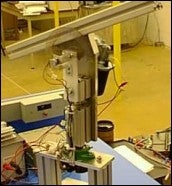Design Team: Michael Healy
Supervisor: Professor David Wang
Background
The Waterloo Aerial Robotics Group (WARG) was established to participate in the Millennial International Aerial Robotics Competition held by the International Association for Unmanned Vehicle Systems. The competition involves having a team of autonomous air and ground vehicles complete a successful search and rescue operation. The robots will try to identify and then determine the exact coordinates of human-like animatronic victims that wave their arms and make audible human sounds. Once the coordinates of the victim(s) has been determined, they may require immediate aid while they wait for a rescue vehicle. The concept of launching first-aid kits, and other rescue devices has been proposed. Various types of rescue devices, depending on the situation, would allow the victim access to immediate aid and perhaps increase their chance of survival. The rescue kits would have to be launched very accurately (winthin one meter of their intended target) due to the possibility that the victim(s) may not be able to move with great ease. To enhance the reality of the disaster area, fire, water and other hazards will be present in the environment and must be avoided. Currently the team has completed two of the three qualifiers for the event and stands in third place.
Project description
The goal of my workshop is too continue the design and construction of a working prototype projectile launcher for the WARG autonomous helicopter. This launcher must be able to fire a ball-bearing at a specified target, no more then a couple meters away, within a maximum error of 2%, in no more then two attempts.


Figure 1: The WARG autonomous Helicopter (Left); The Current Manipulator Prototype (Right)
Design methodology
The manipulator was designed to allow for a maximum range of vertical and horizontal firing angles. Incorporating two joints in the design simplified the launcher problem, by allowing the focus of the design to only be placed on achieving a fixed and repeatable firing speed. Once the durability of the launcher is ensured, control algorthms will then be generated to guarantee the required percision and accuracy. This will include such methods as self-calibration and error correction mechanisms.